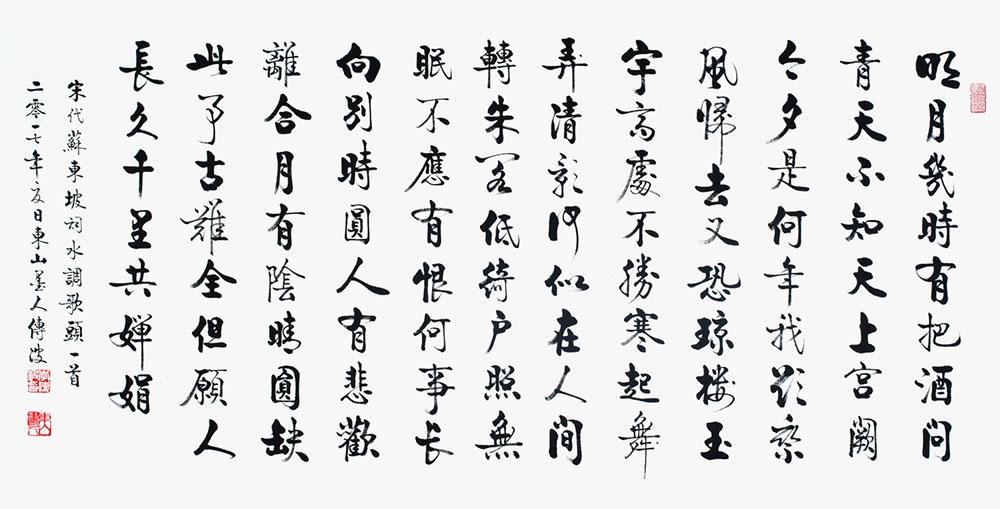In the transition letter from sinshu style to caoshu style, there are no such template rules as in kaishu style, it can be considered a style of sinshu with elements of caoshu, or caoshu with elements of sinshu. What features does the calligraphy of the transition letter from sinshu to tsaoshu have? On the one hand, this style of calligraphy is not so template and standardized, like the kaishu style, but on the other hand, it is not as sloppy and difficult to recognize as the caoshu style. We can say that it has absorbed the advantages of both styles. Further, the features of the calligraphy of the transition letter from sinshu to caoshu styles will be presented in detail.
The features of calligraphy of the transition letter from sinshu style to tsaoshu style
1. Accelerated brush movement
One of the distinctive features of the transition letter from sinshu style to caoshu style from kaishu is that in the first one-the brush movement is faster. This is due to the fact that the sinshu letter was mostly used in the drafts, writing letters, since you can simultaneously invent the content and immediately write it down, and the letter to kaishu in this case is not suitable, because it does not keep up with the flow of thoughts. Some of the letters and manuscripts that have come down to us from ancient times were written under similar conditions.
The effect, obtained from the accelerated movement of the brush, makes the features easy and free, sometimes even the “magnificent white” style of feibai style(a style of calligraphy with white gaps, as if the brush did not have enough ink).
2. The Increase in number of connecting hooks
Due to the fast brush movement in the calligraphy of the transition letter from sinshu to caoshu style, small connecting hooks appear at the places, where the features connect with each other, which make the features more smooth and lively, mutually harmonizing, the overall appearance also becomes more connected. In sinshu style, connecting features appear on the right and on the left, sometimes they can be connected in a kind of web, but in total there are not many of them.
The distinctive feature of the tsaoshu style is also the fact that the brush can specifically break off in the spaces above and below the hieroglyphs, but the overall appearance still remains connected.
3. The alternating of kaishu and caoshu styles.
From the point of writing style, there are more hooks and fewer thread – like traces between the words in the calligraphy of the transition letter from sinshu to caoshu style, from the point of composition, it is the alternation of kaishu and caoshu styles. There is no definite correlation between them. If kaishu prevails, this style is called the transition style from kaishu style to sinshu style, if caoshu style prevails– then it is sinshu style with a transition to caoshu. In total, there are three types of changes:
1) The main place in the composition is occupied by kaishu-style hieroglyphs. In other words, the kaishu letter prevails. In terms of composition, in comparison with the usual kaishu, there will be more slopes, the number of connecting hooks and thread-like traces in lines increases.
2) From the point of structure, the main place is occupied by the hieroglyphs with alternating style between kaishu and caoshu styles. In other words, in most cases it is kaishu style, but also partially present simplified sinshu. For example, in the hieroglyph “flower” only the upper part 艹 can be written in the caoshu style, in the hieroglyph 得 (get) the left part can be written in the style of tsaoshu. In fact, this is the hieroglyphs that came from the people in non-normative (everyday) way, nowadays, the simplified hieroglyphs are used.
3) In terms of layout, the main place is occupied by the hieroglyphs with alternating between kaishu and caoshu styles. Part of the composition is occupied by a neat kaishu style, and another part-by the changing caoshu. The interweaving of styles take place, it seems that there are tight and free spaces, there are flat and sloping hieroglyphs, their size is not the same, it creates the contrast. In the part, where the caoshu style is used, it is better to use most convenient forms of hieroglyphs for better recognizing , you shouldn`t use too changing style of “mad cursive (caoshu)”, and there are also few common ways to write in caoshu style.
The main features of the calligraphy of the transition letter from sinshu style to caoshu style. This type of calligraphic style can be considered as a combination of two styles, which everyone should pay attention to in their daily practice. Of course, success in calligraphy does not come in one day!
I hope that you will try your best and tirelessly stick to daily practice!
Original author: TD “Art feast” (Iyan)

